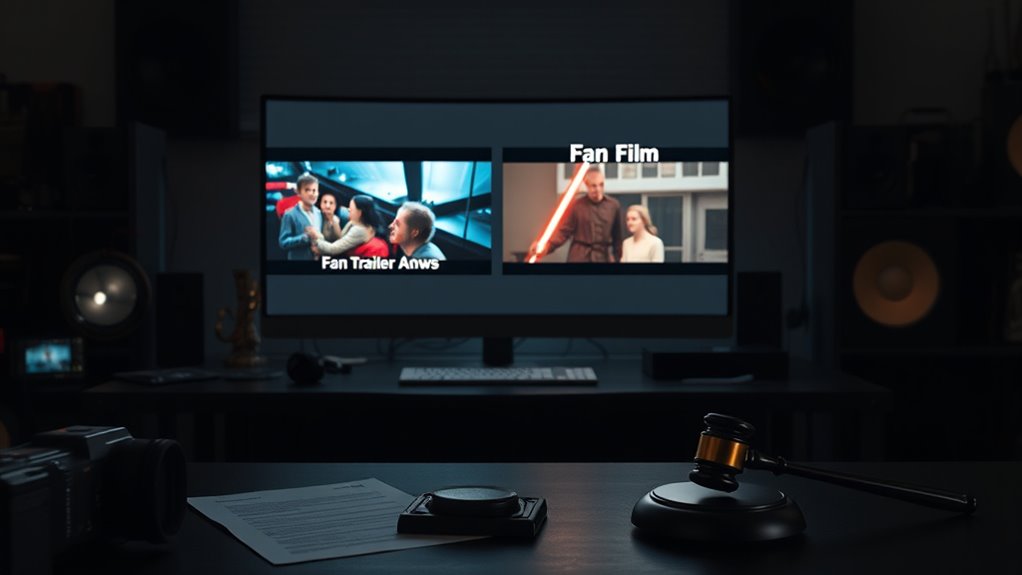Fan trailers are short, preview-style clips meant to hype a media property, often using quick cuts and snippets, while fan films are longer projects that tell a story within an existing universe. Legally, trailers are more likely to fall under fair use if they add transformative value, but fan films risk infringing copyright if they don’t. Understanding these differences and how copyright, duration, and originality play a role helps you stay compliant—learn more about how to navigate these legal boundaries.
Key Takeaways
- Fan trailers are short promotional clips focused on previewing content, often relying on quick cuts and music, with fewer legal restrictions.
- Fan films are longer, narrative projects that tell a story within a universe, making them more likely to raise copyright concerns.
- Trailers typically evoke excitement without full storytelling, while fan films aim for a complete, standalone experience, affecting legal scope.
- The use and transformation of copyrighted material in trailers are generally more limited, whereas fan films require more extensive use, increasing legal risk.
- Legal considerations depend on factors like duration, purpose, and degree of transformation, with trailers often falling under fair use more easily than full fan films.
Defining Fan Trailers and Fan Films

Fan trailers and fan films are creative works made by enthusiasts to celebrate their favorite media, but they serve different purposes and formats. Understanding fan film distinctions helps clarify these differences. Fan trailers typically use trailer terminology, emphasizing quick cuts, dramatic music, and snippets to hype a series or movie. They aim to evoke excitement without telling a full story. Fan films, on the other hand, are longer, more narrative-driven projects that attempt to tell a story or explore characters within the universe. While trailers focus on previewing, fan films seek to create a complete experience. Recognizing these differences is essential, especially when considering legal boundaries, as the intent and scope of each work vary markedly. Additionally, visual organization systems can be used in the presentation of fan projects to create visual interest and highlight key elements, which may influence how their legality is perceived by content owners. Understanding the copyright implications of each type of project is crucial for creators to avoid potential infringement issues. Furthermore, the financial stakes involved in high-profile fan works can impact how content owners approach legal action or licensing discussions. It is also important to consider how content ownership influences whether such projects are tolerated or subject to takedown, affecting creators’ ability to share their work freely.
The Role of Fair Use in Fan Creations

Fair use can shield fan creations like trailers and films from copyright claims, but it depends on specific criteria being met. You need to think about whether your work is transformative and how much original content you use, which can pose risks. Additionally, understanding filtration technologies and their role in content creation can also influence how fair use is applied in these cases. Recognizing the impact of content modification is essential in evaluating whether a work qualifies as fair use, especially when alterations are made to the original material. Moreover, the application of projector technology concepts like resolution and contrast can metaphorically relate to how closely a fan work adheres to or deviates from the original source material. Considering delivery trends and how content is distributed can further affect the fair use analysis, especially with the rise of digital and streaming platforms. It is also important to assess the transformative nature of the fan work, as courts often consider whether the new creation adds value or provides a different perspective.
Fair Use Criteria
Have you ever wondered how copyright law applies to fan creations like trailers and films? Fair use plays a key role in determining whether your work is protected or infringing. To qualify, your project must meet several criteria, including purpose and character—such as criticism, commentary, or parody—showing transformative use. If your creation profoundly alters the original, it’s more likely to qualify for fair use, reducing concerns about trademark infringement or violating moral rights. Additionally, evaluating the use of water in your work, such as incorporating aquatic themes or visuals, can influence fair use considerations. Recognizing the legal risks associated with fan content is essential for assessing your project’s legality and protecting your rights. Understanding the fair use criteria is essential for assessing your project’s legality and protecting your rights. Understanding how AI technology might assist in creating or analyzing fan content can also impact fair use evaluations. For example, electric bikes are increasingly incorporated into fan videos to showcase modern themes, which may support a transformative purpose. However, if your work copies too much of the original without adding new meaning, it might not qualify. Remember, fair use isn’t a blanket defense; it’s evaluated case by case. Understanding these criteria helps you navigate legal boundaries while respecting the rights of original creators.
Transformative Content Risks
Transformative content is a crucial factor in determining whether fan creations qualify for fair use, but it also introduces significant legal risks. If your work is too similar or fails parody considerations, it risks infringement. You could face emotional distress over moral rights, especially if your work alters the original’s intent or meaning. Understanding the specific personality traits involved in your creative process can help assess how your work is perceived and whether it crosses legal boundaries. Recognizing the importance of content originality can guide you in creating work that respects legal standards. Additionally, considering the transformative nature of your work can influence how courts interpret fair use, emphasizing the importance of adding new expression or meaning. Consider these risks: 1. Legal backlash if your fan creation is seen as unoriginal or infringing. 2. Moral rights violation if the original creator feels misrepresented or harmed. 3. Loss of creative freedom when balancing parody considerations with fair use, risking your ability to innovate freely. Understanding these factors helps you navigate the fine line between transformative fair use and legal exposure, especially when your work challenges or reinterprets existing content.
Copyright Balance Challenges
Balancing copyright considerations in fan creations is a complex challenge because it requires you to respect the original work while expressing your own creativity. You must navigate the delicate line of maintaining legal compliance with intellectual property laws while showcasing your passion. Fair use plays a vital role here, but it’s not a guarantee of protection. Factors like the purpose of your work, its transformative nature, and the amount used influence whether your fan creation qualifies as fair use. You need to be aware that even if your project is non-commercial or transformative, copyright holders can still challenge it. As a result, understanding the nuances of copyright balance helps you avoid infringement risks and supports your right to create within the legal framework.
Copyrighted Material and Its Limitations

Copyrighted material plays a crucial role in defining the boundaries of fan-created content, including trailers and films. You must respect these limits to avoid legal trouble. Creative uses like parody protections offer some flexibility, but only under specific conditions. Licensing agreements can grant permission, yet they’re not always available or easy to obtain. Additionally, understanding auditory processing techniques can help creators develop more engaging content without infringing on original works. Recognizing the importance of regional legal resources can aid in navigating local laws and regulations that may impact your project. Moreover, awareness of copyright laws and how they apply to derivative works is essential for staying compliant and protecting your creative efforts. Consider these emotional points: 1. The risk of infringement threatens your passion and creativity. 2. Unauthorized use can lead to costly lawsuits, ending your project. 3. Proper licensing or relying on fair use may be your only hope, but they come with restrictions. Understanding these limitations helps you navigate the fine line between inspiration and infringement, ensuring you stay within legal bounds while expressing your fandom.
Duration and Distribution Factors

The length of your fan content and how you distribute it can considerably impact its legal status. Duration limitations matter because shorter works are often seen as more acceptable under fair use, especially if they serve a transformative purpose. Fan trailers, typically brief, are less likely to trigger copyright concerns, whereas longer fan films risk exceeding acceptable duration limits. Additionally, content duration plays a crucial role in determining whether your fan work falls within fair use boundaries. Shorter works are also easier to justify as transformative use, which is a key factor in fair use analysis. Distribution restrictions also play a vital role; sharing your content on personal platforms or limited audiences reduces the likelihood of legal issues. Publicly posting full-length fan films on popular video sites increases exposure and potential enforcement actions. By keeping your content concise and controlling its distribution, you better align with fair use principles and minimize legal risks associated with copyright infringement. Additionally, understanding Glycolic Acid Benefits for Skin can help you make informed decisions about skincare products containing active ingredients.
The Importance of Originality and Transformative Content

Your work should offer a creative adaptation that adds new meaning or perspective, meeting transformative standards. By making your content original and distinct, you enhance its value and reduce legal risks. Focusing on originality helps you avoid the pitfalls of simply copying existing material.
Creative Adaptation Standards
Creative adaptation standards emphasize the importance of originality and transformative content in fan works. Your contributions should enrich the fan community dynamics by offering fresh perspectives that distinguish your work from the original. This not only respects intellectual property nuances but also demonstrates your creativity. To evoke emotion and guarantee your work aligns with these standards, focus on:
- Creating unique stories that add new depth or meaning.
- Using elements from the original work in ways that transform their context.
- Avoiding mere replication; instead, aim for meaningful reinterpretation.
Transformative Works’ Value
Transformative works hold significant value because they demonstrate originality and creative reinterpretation of existing content. By adding your unique perspective, you foster fan engagement that deepens emotional connections to the original material. These works often spark community impact, bringing fans together to share ideas and appreciation. When you create something transformative, you’re not just copying; you’re contributing new insights, narratives, or visuals that enhance the fandom experience. This originality encourages discussion and participation, strengthening the community as a whole. Your creative reinterpretations highlight the cultural relevance of the original work while showcasing your individual voice. Ultimately, the value of transformative works lies in their ability to enrich the fan landscape, promote innovative dialogue, and celebrate shared passions through original, meaningful content.
Avoiding Derivative Risks
Building on the value of transformative works, it’s important to understand how to protect yourself from legal risks associated with derivative content. In the fan community, originality and transformative elements are vital for avoiding claims of infringing on intellectual property. To minimize risks:
- Create unique content that adds new perspectives or commentary, making your work clearly transformative.
- Use minimal copyrighted material and ensure any clips or images are legally obtained or fair use.
- Document your process and sources to demonstrate your intent to be original and respectful of intellectual property rights.
Legal Risks of Unauthorized Use

Unauthorized use of copyrighted material can lead to serious legal consequences, even if your intent is to celebrate or pay homage to a franchise. When you create fan content without permission, you risk infringing on merchandise licensing agreements and character rights. These rights are carefully protected by copyright law, and using copyrighted images, videos, or sound without authorization can result in lawsuits, fines, or injunctions. Companies actively monitor for unauthorized fan creations to defend their intellectual property. Even if your project isn’t for profit, it still may be considered an infringement. Understanding the importance of respecting merchandise licensing terms and character rights helps you avoid legal trouble and demonstrates good faith in honoring the original creators’ rights.
Best Practices for Staying Compliant

To stay compliant when creating fan trailers or fan films, you should always seek permission from the rights holders before using any copyrighted material. Understanding licensing requirements and licensing exemptions can help you avoid legal trouble. Here are key best practices:
- Reach out early to obtain explicit permission, ensuring your project aligns with licensing requirements.
- Research licensing exemptions that may apply, such as fair use, but don’t rely solely on assumptions.
- Keep detailed records of permissions, licenses, and correspondence to prove your good faith efforts.
Frequently Asked Questions
Can Fan Trailers Be Monetized Legally?
You might wonder if fan trailers can be monetized legally. Generally, trailer monetization isn’t permitted without proper fan film licensing, as it involves copyrighted content. Companies closely guard their rights and may oppose trailer monetization, especially if it promotes commercial gain. To stay compliant, you should seek licensing agreements or permissions. Without proper fan film licensing, monetizing your fan trailers could lead to copyright infringement claims.
How Does Parody Affect Fan Film Legality?
Think parody is harmless fun? Think again. When creating a fan film, parody can be a double-edged sword, especially with trademark concerns. If your content is transformative—adding new meaning or critique—you might dodge legal trouble. However, if it’s too close to the original, courts may see it as infringement. So, always aim for transformative content and be mindful of trademarks to keep your parody legally safe and creatively sharp.
Are Fan Films Ever Protected Under Fair Use?
You wonder if fan films are ever protected under fair use. While fan film licensing varies, courts may grant copyright exemptions if your film transforms the original work, adds new meaning, or offers commentary. However, fair use isn’t guaranteed. You should carefully consider these factors, as legal protections depend on how your fan film is created and its purpose, potentially qualifying it for fair use under certain circumstances.
What Penalties Can Creators Face for Copyright Infringement?
Imagine walking a tightrope over a canyon—one misstep can lead to a fall. When you face copyright infringement, the legal consequences can be severe, including fines, injunctions, or even lawsuits. Copyright enforcement aims to protect creators’ rights, and failure to comply might cost you financially and tarnish your reputation. You need to understand these risks to avoid penalties that could derail your creative efforts entirely.
How Can Fans Ensure Their Content Remains Compliant?
To keep your content compliant, stay active within the fan community and respect copyright laws. Focus on maintaining content originality by creating transformative work that adds new meaning or insight. Avoid using copyrighted material without permission, and always credit original creators. By doing so, you help protect yourself from legal issues while supporting a positive, respectful fan environment. Remember, responsible content creation benefits everyone involved.
Conclusion
Understanding the legal landscape is like steering a minefield—you need to tread carefully. By respecting copyright laws, emphasizing originality, and staying within fair use boundaries, you can create fan trailers and films that shine without risking legal trouble. Think of it as sailing a ship through calm waters—staying compliant ensures your creative journey remains smooth and safe. Remember, staying informed helps you turn your passion into a masterpiece, not a legal minefield.









